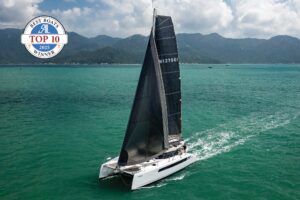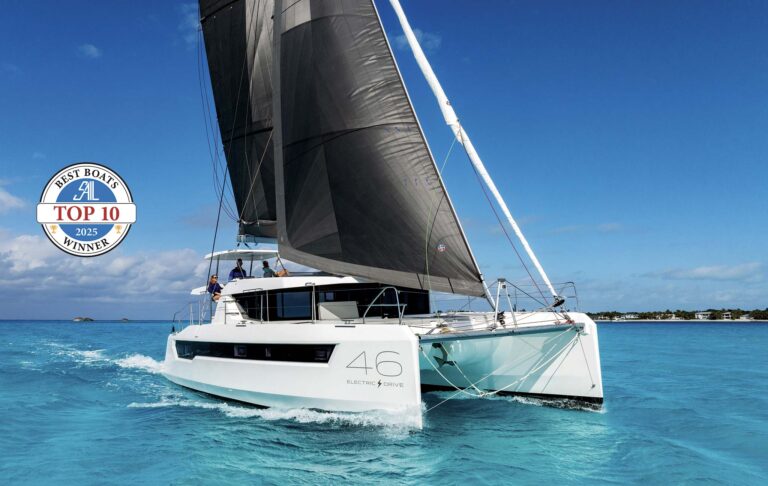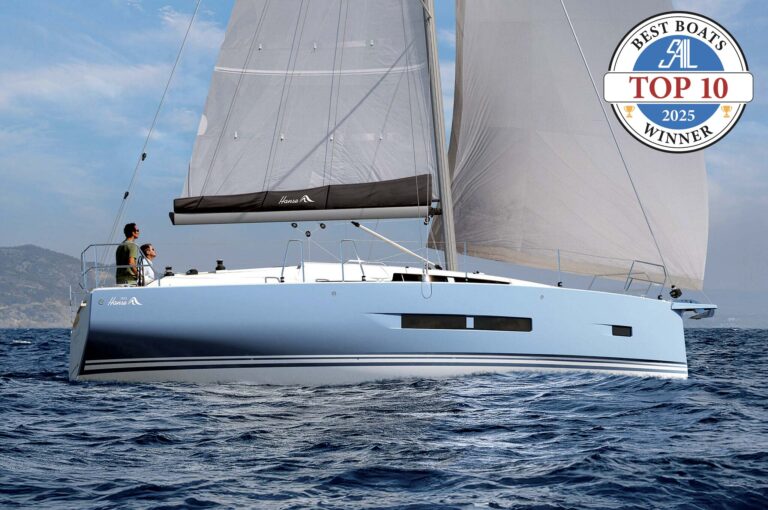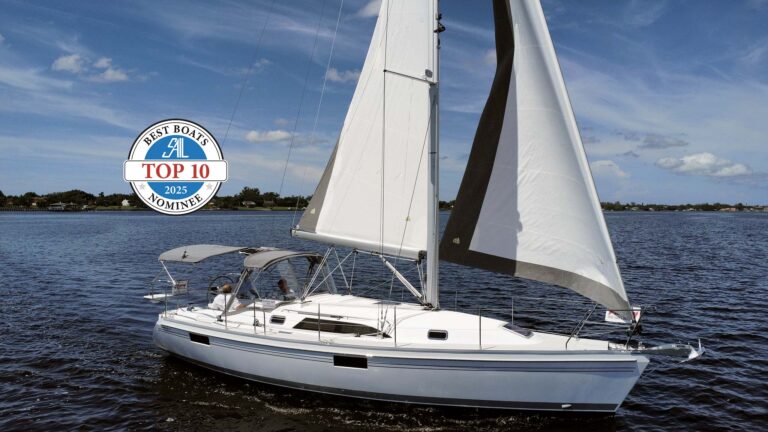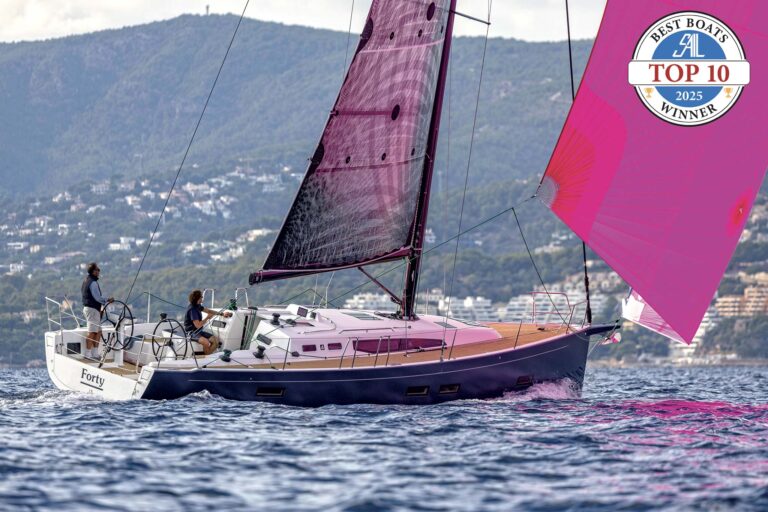
A 49-foot cruiser with lots of bells and whistles
By Bill Springer
Head designer Glenn Henderson has redesigned the entire Hunter line since he arrived in 1998, and now, starting with the new Hunter 49, he’s in the process of refining his redesigns. I jumped aboard hull #1 with Hunter’s chief tester, Steve Pettingill, on a 180-mile passage from St. Augustine, Florida, to Charleston, South Carolina, to see how the new flagship performs offshore.
Under way
Conditions could not have been better for my test sail if they had been ordered from a weather menu. We experienced winds from 2 to 30 knots, and our northeasterly course required our point of sail to slowly change from close-hauled to a deep reach and back to close-hauled on the opposite tack. We departed St. Augustine in flat water and sailed through most of the night in building winds and following seas.
I was impressed with the 49’s upwind performance in light air. In 8 to 12 knots of wind and flat water, we logged 7 knots of boatspeed and tacked through 80 degrees. It took some time to accelerate out of the tacks, but once we got the sails dialed in, the boat tracked well and held consistent speed. Broad- and beam-reaching through the night, with winds in the high 20s, speeds were consistently in the 8-to-9-knot range and occasionally topped 10 knots. Some trouble with the autopilot had us hand-steering through the windiest hours.
The helm-station sheet leads allowed for easy singlehanded sail trim, and a shallow well behind each wheel provided a standing helmsman welcome brace points as the boat heeled. The helm was responsive but stiff. It didn’t feel like a major design flaw, but rather like the Lewmar Mamba steering system needed some fine-tuning.
We rolled up a good chunk of the in-mast-furling main and the jib as windspeed hit the high teens and reefed even more as it went to the mid-to-upper 20s. The boat was well behaved as the wind increased, the cockpit was dry, and we never came close to rounding up. I was even able to get some sleep in the forward master cabin during the windiest part of the night.
Under power we logged 8 knots of boatspeed at 2,500 rpm. Maneuverability was excellent, thanks to the bow thruster, and engine noise was held to a minimum, thanks to stout engine insulation and tight-fitting engine-access points. With the boat’s 150-gallon fuel capacity, range under power (or generator running hours) is substantial.
Belowdecks
The 49’s new bells and whistles have to do with creature comforts. The flat-screen TV with Bose surround sound in the saloon is bigger and sharper than my TV at home. The galley has four separate refrigeration units, Corian countertops, and glass-paneled cabinet doors complete with LED cabinet lighting. A fan and a drain that’s plumbed into the bilge allow the plate and mug storage cabinet to double as an out-of-the-way dish dryer.
As with all Hunters, there’s never a shortage of sheer accommodation space. The 49 is a beamy boat (14 feet, 9 inches), but doesn’t appear super-beamy. The airy saloon will seat eight for dinner. It has two excellent seaberths and 6-foot, 9-inch headroom. Numerous fixed ports let in lots of light.
The nav station has a good-size table and a luxurious “Captain Kirk” bucket seat. The master cabin has excellent headroom, a walk-around double bunk, two hanging lockers, several cabinets, two opening hatches, an ensuite head with separate shower, and, of course, another flat-screen TV. Two identical guest cabins aft will sleep two couples comfortably, but are considerably tighter than the master.
Numerous handholds in the saloon—two sturdy posts near the companionway and grabrails below the ports—provide uninterrupted brace points for navigating around the large cabin. However, the grabrails had a bit of give when I really yanked on them, and the companionway needs additional handholds so there’s something to hang onto when you’re on the first step. Whatever you do, don’t grab the purely ornamental light strip that’s built into the vinyl headliner near the coachroof.
Lifting the floorboards revealed a welcome and frankly surprising sight—an enormous deep sump with centrally mounted through-hulls. The boat’s considerable depth below the floorboards also allows for low-down, sailing-performance-friendly mounting of the generator and engine on centerline in the lowest part of the boat. The sump gets two thumbs way up.
Conclusion
I liked the 49’s speed potential, and its manners under sail were never in question because we reefed when we were supposed to. The return of a deep bilge sump (as opposed to the ultra-shallow sumps in many new cruising boats) was a welcome surprise, and it’s good to see some of the heavy stuff (engine and generator) placed where their weight doesn’t compromise ultimate stability. And what’s not to like about centrally mounted through-hulls? That said, the steering did feel a bit stiff, the grabrails in the saloon had some give, and the recessed lighting near the companionway may not appeal to everyone. Overall, the boat was condo-comfortable, but also handled the passage without trouble.
Price: $319,900 (base, sailaway FOB Alachua, FL) includes
B&R rig, full-roach main with flaking system, arch-mounted
traveler system, electric windlass, freshwater hot/cold transom shower, flat-screen TV, Bose Surround Sound, Raymarine ST 60 knot/depth, VHF.
Builder: Hunter Marine, Alachua, FL; www.huntermarine.com, tel. 800-771-5556
Designer: Hunter Design Team
Construction: Hull is solid hand-laid fiberglass below
the waterline and cored with end-grain balsa above. Bow is
reinforced with Kevlar. Deck is cored with end-grain balsa;
hardware mounting points are backed with solid-aluminum plates. Keel is lead. All through-hulls are bronze. Hull-to-deck joint is formed by two outward-turning flanges that are both bolted and bonded with 5200 adhesive.
Pros: Clever new comfort features, deep bilge sump, general
sailing performance.
Cons: Stiff steering, ornamental mood lighting
in the headliner, limited saloon ventilation.
Specifications
LOA – 49’11”
LWL -43’10”
Beam -14’9″
Draft (shoal/deep) – 5’6″ or 7′
Displacement (shoal) – 32,813 lbs
Ballast (shoal/deep)- 12,544/11,216 lbs
Sail Area (main and jib) – 1,014 sq ft
Fuel/water/waste – 150/200/52
gals
Electrical -(3) 8D (600 Ah) battery;
(1) Group 34 starting battery;
100-amp battery charger
Displacement-Length ratio- 133
Sail Area-Displacement ratio – 15.9
Ballast ratio -38%


